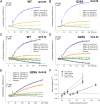Engineering rotor ring stoichiometries in the ATP synthase
- PMID: 22628564
- PMCID: PMC3382517
- DOI: 10.1073/pnas.1120027109
Engineering rotor ring stoichiometries in the ATP synthase
Abstract
ATP synthase membrane rotors consist of a ring of c-subunits whose stoichiometry is constant for a given species but variable across different ones. We investigated the importance of c/c-subunit contacts by site-directed mutagenesis of a conserved stretch of glycines (GxGxGxGxG) in a bacterial c(11) ring. Structural and biochemical studies show a direct, specific influence on the c-subunit stoichiometry, revealing c(<11), c(12), c(13), c(14), and c(>14) rings. Molecular dynamics simulations rationalize this effect in terms of the energetics and geometry of the c-subunit interfaces. Quantitative data from a spectroscopic interaction study demonstrate that the complex assembly is independent of the c-ring size. Real-time ATP synthesis experiments in proteoliposomes show the mutant enzyme, harboring the larger c(12) instead of c(11), is functional at lower ion motive force. The high degree of compliance in the architecture of the ATP synthase rotor offers a rationale for the natural diversity of c-ring stoichiometries, which likely reflect adaptations to specific bioenergetic demands. These results provide the basis for bioengineering ATP synthases with customized ion-to-ATP ratios, by sequence modifications.
Conflict of interest statement
The authors declare no conflict of interest.
Figures









Similar articles
-
Bayesian inference of rotor ring stoichiometry from electron microscopy images of archaeal ATP synthase.Microscopy (Oxf). 2018 Oct 1;67(5):266-273. doi: 10.1093/jmicro/dfy033. Microscopy (Oxf). 2018. PMID: 30032235
-
The structural features of Acetobacterium woodii F-ATP synthase reveal the importance of the unique subunit γ-loop in Na+ translocation and ATP synthesis.FEBS J. 2019 May;286(10):1894-1907. doi: 10.1111/febs.14793. Epub 2019 Mar 12. FEBS J. 2019. PMID: 30791207
-
High-resolution structure and mechanism of an F/V-hybrid rotor ring in a Na⁺-coupled ATP synthase.Nat Commun. 2014 Nov 10;5:5286. doi: 10.1038/ncomms6286. Nat Commun. 2014. PMID: 25381992 Free PMC article.
-
Cryo-EM of ATP synthases.Curr Opin Struct Biol. 2018 Oct;52:71-79. doi: 10.1016/j.sbi.2018.08.005. Epub 2018 Sep 18. Curr Opin Struct Biol. 2018. PMID: 30240940 Review.
-
F1F0-ATP synthases of alkaliphilic bacteria: lessons from their adaptations.Biochim Biophys Acta. 2010 Aug;1797(8):1362-77. doi: 10.1016/j.bbabio.2010.02.028. Epub 2010 Mar 1. Biochim Biophys Acta. 2010. PMID: 20193659 Free PMC article. Review.
Cited by
-
Here comes the sun: How optimization of photosynthetic light reactions can boost crop yields.J Integr Plant Biol. 2022 Feb;64(2):564-591. doi: 10.1111/jipb.13206. J Integr Plant Biol. 2022. PMID: 34962073 Free PMC article. Review.
-
A new type of Na(+)-driven ATP synthase membrane rotor with a two-carboxylate ion-coupling motif.PLoS Biol. 2013;11(6):e1001596. doi: 10.1371/journal.pbio.1001596. Epub 2013 Jun 25. PLoS Biol. 2013. PMID: 23824040 Free PMC article.
-
The c-ring stoichiometry of ATP synthase is adapted to cell physiological requirements of alkaliphilic Bacillus pseudofirmus OF4.Proc Natl Acad Sci U S A. 2013 May 7;110(19):7874-9. doi: 10.1073/pnas.1303333110. Epub 2013 Apr 23. Proc Natl Acad Sci U S A. 2013. PMID: 23613590 Free PMC article.
-
Rotor subunits adaptations in ATP synthases from photosynthetic organisms.Biochem Soc Trans. 2021 Apr 30;49(2):541-550. doi: 10.1042/BST20190936. Biochem Soc Trans. 2021. PMID: 33890627 Free PMC article. Review.
-
The Minimum Biological Energy Quantum.Front Microbiol. 2017 Oct 25;8:2019. doi: 10.3389/fmicb.2017.02019. eCollection 2017. Front Microbiol. 2017. PMID: 29123504 Free PMC article. Review.
References
-
- Abrahams JP, Leslie AGW, Lutter R, Walker JE. Structure at 2.8 Å resolution of F1-ATPase from bovine heart mitochondria. Nature. 1994;370:621–628. - PubMed
-
- von Ballmoos C, Wiedenmann A, Dimroth P. Essentials for ATP synthesis by F1F0 ATP synthases. Annu Rev Biochem. 2009;78:649–672. - PubMed
-
- Junge W, Sielaff H, Engelbrecht S. Torque generation and elastic power transmission in the rotary FoF1-ATPase. Nature. 2009;459:364–370. - PubMed
-
- Noji H, Yasuda R, Yoshida M, Kinosita K., Jr Direct observation of the rotation of F1-ATPase. Nature. 1997;386:299–302. - PubMed
-
- Iino R, Rondelez Y, Yoshida M, Noji H. Chemomechanical coupling in single-molecule F-type ATP synthase. J Bioenerg Biomembr. 2005;37:451–454. - PubMed
Publication types
MeSH terms
Substances
LinkOut - more resources
Full Text Sources
Other Literature Sources

